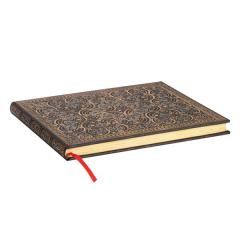Nobility and grace are restored in our filigreed Restoration design. Originally crafted in 1675 by the Queens’ Binder “A,” the balance of open space and intricate elements make it a shining jewel of the period. The binding was created to hold The Government of the Tongue by Richard Allestree, provost of Eton College.
Nobility and grace are restored in this striking filigree design. Originally crafted by the Queens’ Binder A, one of the most prolific book binders of the Restoration period, the binding held Richard Allestree’s The Government of the Tongue. The balance of open space and intricate elements, like the gorgeous frame and harmonious little stars, make it a shining jewel of 17th-century English bookbinding.
The “Queens’ Binder” was a name given by G.D. Hobson to a small group of English bookbinders during the “Golden Age of English Bookbinding.” They were known for featuring pointillé outlines rather than floral volutes, which were much more widely used during the era. Modern research indicates that the Queens’ Binder was in fact four distinct shops, and even individual binders such as “A” could refer to multiple artisans.
While the name or names of the binder called “A” is not known, at least one of the artists is thought to be William Nott, an important figure in the book trade who operated as a bookseller, stationer and publisher. The quality of the bindings attributed to A also vary considerably, but there is no question as to the excellence of this specific piece. The Government of the Tongue was an important work during its day and, as provost of Eton College, Allestree would have been able to demand the highest quality for his publication.
Today, the original binding is a part of the Henry Davis gift at the British Library. We are happy to have had the opportunity to restore it to its original glory for this Paperblanks design.





